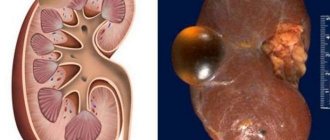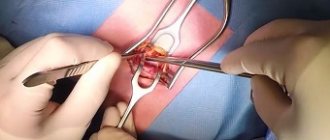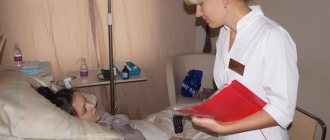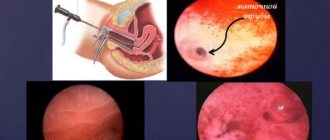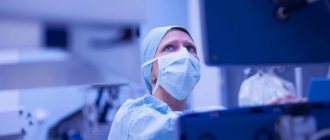Today, the medical industry has fundamentally new technologies for surgical interventions. One of these achievements of modern science is laparoscopy - a safe, low-traumatic and short-term operation that does not require a long recovery period. Laparoscopic interventions are carried out using probes that are equipped with a camera and special lighting that allows you to examine all the details of the operated area. They are inserted through small (no more than two centimeters) incisions on the skin.
This surgical technique is widely used in gynecology - after such an operation there are no noticeable cosmetic defects left on the skin of the abdomen, moreover, rehabilitation proceeds quickly and without any serious complications. In some cases, after laparoscopy, women note the appearance of discharge - this can be either a natural phenomenon or a sign of a pathological process.
In our article we want to talk about the specifics of laparoscopic surgery, the rules of preparation for the procedure, the characteristics of the rehabilitation period of the female body and explain whether brown discharge after laparoscopy is a pathology.
When is laparoscopy used in gynecological practice?
Practicing gynecologists use this minimally invasive diagnostic and surgical technique much more often than other medical specialists. Indications for laparoscopic and hysteroscopy (a method of examining the cervix and uterine cavity) are:
- endometriosis – growth of the endometrium (inner layer of the uterine walls);
- fibroids are benign neoplasms that form in the myometrium (muscular layer of the uterus);
- torsion of a benign ovarian tumor (cyst) or its rupture;
- ovarian apoplexy - a sudden violation of the integrity of its tissues;
- anomalies of the anatomical structure of the genital organs and malformations of their development;
- infertility;
- ectopic pregnancy - when the attachment of a fertilized egg can occur in the peritoneum, fallopian tube, cervix or ovary;
- initial stages of the malignant process.
Thanks to the capabilities of laparoscopy, the treatment of many pathologies of the female reproductive system has become much more successful.
Rules for preparing and avoiding complications
Before any planned operation, the patient is pre-examined. After a conversation with a medical specialist and a physical examination by a gynecologist, the woman undergoes:
- general clinical urine and blood tests;
- biochemical blood test;
- coagulogram - assessment of coagulation system factors;
- determination of blood group and rhesus affiliation;
- fluorography;
- electrocardiogram;
- Ultrasound;
- serological tests for the presence of antibodies to HIV, syphilis, and hepatitis viruses.
Features of the postoperative period
The duration of recovery of the female body depends on the extent of the surgical intervention performed (for example, removal of an ovarian cyst requires rehabilitation of about 5 days). After laparoscopy, patients note a feeling of discomfort in the abdomen. This phenomenon is associated with the technique of manipulation - to increase the space for intervention, carbon dioxide is injected into the abdominal cavity.
With low-traumatic laparoscopy, a woman’s body recovers much faster than after exploratory laparotomy, a surgical operation in which the abdominal wall is cut to access the internal organs. Limiting physical activity and following the advice of your doctor speeds up recovery.
Additional recommendations
The stay in the hospital during laparoscopy after surgery does not exceed 6 days. This period is realistic only if the patient does not experience any complications after surgery. After this period, the patient is discharged, and the entire subsequent rehabilitation period takes place at home. At the same time, we should not forget that for 1-1.5 months after discharge she must not only follow a diet, but follow other doctor’s recommendations, the main ones of which include:
- Carrying out daily treatment of sutures with special antiseptic preparations, which continues until they are completely healed. For these purposes, the patient can visit the clinic or perform these actions independently;
- ensuring complete sexual rest and abstinence from sexual intercourse to allow the restoration of internal organs and the beginning of their normal functioning;
- restriction of physical activity and refusal to play sports. The maximum weight that the patient can lift is 3 kilograms. Compliance with this recommendation is necessary to ensure that the abdominal muscles are completely at rest;
- staying in the fresh air, which will ensure that the body receives the necessary amount of oxygen required for the normal functioning of all organs and for their rapid recovery. In addition, walking is not an intense physical activity, but at the same time it improves blood circulation and also prevents the formation of blood clots and adhesions;
- refraining from traveling on public transport, as well as traveling by plane;
- ban on visiting saunas, steam baths, solariums and swimming pools.
If the puncture sutures are made with non-absorbable threads, they are removed approximately a week after laparoscopy. Throughout this time, the patient must protect the damaged area when performing water procedures. In this case, taking a bath is prohibited.
After gynecological laparoscopy, the postoperative period may be accompanied by slight bleeding from the genitals. This is a completely normal phenomenon that should not be feared. But you should immediately consult a doctor if such discharge becomes profuse and bright red with the presence of blood clots. Such manifestations may occur when an infection or other complication occurs that requires specific treatment.
Thus, the postoperative period after laparoscopy consists of following a diet, limiting physical activity and abstaining from sexual intercourse. Otherwise, the patient can lead a normal lifestyle, paying attention to changes in her body. If pain or other signs of complications begin, she should contact her doctor so that he can promptly determine their cause and prescribe appropriate treatment.
What kind of discharge may appear after laparoscopy?
Within three weeks after surgery, there is a slight, transparent discharge from the vagina, with a slight splash of blood. This phenomenon is normal and should not cause any concern to a woman - it is associated with the healing of damaged tissue.
During this time, the patient must carefully comply with all personal hygiene requirements and refrain from intimate contact. Intense bleeding (especially with blood clots) is considered pathological - this is a signal of internal bleeding.
Leucorrhoea that is brown or yellow-green in color and has an unpleasant odor indicates a bacterial infection. White discharge, accompanied by itching and burning, may indicate candidiasis (or thrush) - the presence of yeast-like fungi Candida Albicans in the genital tract.
In the postoperative period, a woman takes antibacterial drugs that weaken the immune system - this provokes the active proliferation of pathogenic bacteria. Also very often, women notice changes in the menstrual cycle. In all of the above cases, the patient should contact the attending physician, who will take immediate action.
Discharge after laparoscopic surgery
Let's consider all types of discharge that may appear after surgery, so that each woman can independently determine whether it is dangerous or not.
- Weak, transparent with small splashes of blood, such a signal is the norm. Brown-green and yellow-green may indicate that the body has an infection. In such a situation, you need the help of a specialist. You may also experience symptoms such as general malaise, weakness, fever, headache, and lower back pain. White, possibly with blood stains. If a woman undergoes laparoscopy while taking antibiotics, thrush may occur, for which such an environment will be favorable. In fact, any provoking factor can become a catalyst for this fungal disease.
In order to prevent candidiasis, try to get plenty of rest, avoid overcooling, and carefully monitor your health. If thrush does occur, do not start taking any medications on your own, visit a doctor, he will prescribe appropriate therapy. Leucorrhoea does not always indicate candidiasis; there may be other sexually transmitted infections.
When will the discharge disappear and the cycle will be restored?
The following complications may develop after laparoscopy:
- adhesions;
- bleeding;
- inflammatory process;
- pathological discharge.
Laparoscopy is considered a safe and low-traumatic method of surgical treatment, which is why complete recovery of the female body occurs in no more than two weeks. For many, menstrual function does not change; surgery is always scheduled on the eighth day of the monthly cycle, and by the beginning of the next menstruation, the woman’s body has time to fully resume its physical activity. Isolation of exfoliated endometrium with blood from the vagina indicates rapid rehabilitation or a hormonal imbalance. As a rule, a small amount of discharge should not cause any concern.
As a rule, the first menstruation after surgery is very heavy and pronounced - this phenomenon is explained by the slow healing of internal organs.
There are other menstrual dysfunctions that are considered normal:
- "Shift" of the monthly cycle. The day of laparoscopy is considered the beginning of a new period; in this case, bleeding occurs after a certain period.
- The discharge of mucous-bloody leucorrhoea is noted immediately after surgical manipulation and lasts approximately 21 days. Their appearance should not be regarded as an alarming signal. If they have an unpleasant odor, you need to contact a laboratory center and have a smear from the genital tract analyzed.
- Long delay - it can be caused by psycho-emotional stress or the effect of anesthesia. The absence of discharge may be a consequence of a violation of the integrity of the tissues of the female reproductive glands (ovaries). If, during a delay in menstruation, a woman experiences abdominal pain and notices the release of blood clots, she must seek medical help, do an ultrasound and undergo tests.
Read more The woman's belly has increased below the navel.
In addition, it should be remembered that monthly bleeding is controlled by complex biochemical processes occurring in the woman's body, taking into account the physiological and nervous system - the functional activity of the hypothalamus and pituitary gland. Failure of the menstrual cycle can be associated not only with medical procedures, but also with any disorder in the female body. Only a qualified doctor can find and eliminate the cause of the absence of menstruation.
RESTORATION OF THE MONTHLY CYCLE AFTER LAPAROSCOPY
As a rule, planned laparoscopy is prescribed on the 7-8th day of the cycle, that is, almost immediately after the end of the next menstruation. If the operation is successful, recovery takes no more than two weeks, which means the next menstruation should begin on schedule.
Many women note that after laparoscopy, menstrual blood flowed more intensely and longer than usual. But, as a rule, heavy periods are not a cause for concern. This is only due to the fact that the tissues of the internal organs take longer to heal than the external integuments.
The opposite situation is also possible - a delay in menstruation. If this is how the body reacts to stress or anesthesia, then you should not interfere - over time the cycle will return to normal. But no matter how many days the period is delayed, the patient should definitely consult a doctor - things can be much more serious.
Long-term absence of menstruation after laparoscopy is most often associated with unsuccessful procedure. If the ovary was damaged during the manipulations, then you may not get your next period. In this case, the woman feels a strong nagging pain in the lower abdomen and sometimes notices blood clots. In this case, you cannot do without qualified medical care. To understand what’s going on, you will need to undergo a series of clarifying tests and be sure to undergo an ultrasound.
Be that as it may, a delay in menstruation is not a reason to blame the doctor. The menstrual cycle depends on the coordinated work of the physiological and nervous systems, which can fail for a reason that has nothing to do with surgical intervention. Medical practice knows of cases where it took more than 6 months to restore the monthly cycle after laparoscopy.
Laparoscopy has been and remains one of the safest and least traumatic ways to solve gynecological problems. In many ways, the duration of the recovery period depends on the patient herself. To avoid complications, you must strictly adhere to your doctor’s recommendations: avoid hot baths, tampons, and intense physical and mental stress for at least a month. Instead, carefully monitor your health, measure your body temperature twice a day, wash yourself regularly and give preference to light foods, eliminating everything fried, fatty and pickled from your diet.
Resuming physical activity and sexual intercourse
The first month after laparoscopy, the patient needs to limit sports activities and any physical activity - returning to the usual rhythm should occur gradually. Intimate life can be resumed 2 weeks after surgery.
Surgical intervention using the laparoscopic method is prescribed for both diagnostic and therapeutic purposes in case of pathological processes accompanying infertility - fallopian tube adhesions, endometriosis, cysts, fibroids, polycystic ovary syndrome, etc. The successful completion of the recovery period indicates that it is already possible to plan the birth child.
When treating infertility, not only surgical but also conservative treatment is used - the use of medications that affect the functional activity of the female reproductive system. That is why it is necessary to plan the birth of a baby after consultation with a practicing obstetrician-gynecologist who has studied the patient’s medical history in detail. If laparoscopy is successful, pregnancy planning can begin within a few months.
Spa treatment
The procedures that will be prescribed help to restore the body weakened after surgery in a short time. Therapeutic measures include:
- Balneotherapy. This is a procedure for taking mineral, radon, carbon dioxide or pine baths. The duration of one session is no more than 12 minutes. The course of therapy is 10 days. The procedure is carried out every other day.
- Electrophoresis. Succinic acid allows you to correct adaptation processes.
- Exercise therapy and dietary compliance.
- Taking medications (Riboxin, Mildronate).
- Drinking warm mineral water.
If a person has undergone cholecystectomy, he simply needs to undergo therapy in a sanatorium-resort setting.
Possible complications
Side effects of this safe procedure are minimized. However, in addition to the appearance of pathological discharge, a woman may experience other symptoms:
- temperature increase;
- general weakness and fatigue;
- loss of consciousness;
- decreased appetite;
- bloating;
- frequent urge to empty the bladder;
- nausea, even vomiting;
- increased pain in the abdomen;
- swelling and hyperemia of suture areas;
- bleeding from wounds;
- pneumonia;
- stroke.
To relieve pain, painkillers are prescribed; medications containing Simethicone can eliminate flatulence. At the end of all the above information, I would like to add that in order to avoid all the unpleasant manifestations of the postoperative period, the patient must follow all the recommendations of the attending physician. In addition, approach the choice of a medical institution and specialist who will perform laparoscopy with all responsibility. And if all the rules of the rehabilitation period are followed, the woman will quickly return to her previous shape and active life without consequences for her health.
Recent Entries
Recent comments
Categories
Features of the postoperative period The duration of recovery of the female body depends on the volume of surgical intervention performed (for example, removal of an ovarian cyst requires rehabilitation of about 5 days). After laparoscopy, patients note a feeling of discomfort in the abdomen. This phenomenon is associated with the technique of manipulation - to increase the space for intervention, carbon dioxide is injected into the abdominal cavity. Postoperative sutures do not need special attention - there is no likelihood of them coming apart, healed scars are practically invisible. With low-traumatic laparoscopy, the woman’s body recovers much faster than after exploratory laparotomy - a surgical operation in which the abdominal wall is cut to access the internal organs. Limiting physical activity and following the advice of your doctor speeds up recovery.
Rehabilitation period after laparoscopy of ovarian cyst
The day of laparoscopy is considered the beginning of a new period; in this case, bleeding occurs after a certain period.
- The discharge of mucous-bloody leucorrhoea is noted immediately after surgical manipulation and lasts approximately 21 days. Their appearance should not be regarded as an alarming signal. If they have an unpleasant odor, you need to contact a laboratory center and have a smear from the genital tract analyzed.
- Long delay - it can be caused by psycho-emotional stress or the effect of anesthesia. The absence of discharge may be a consequence of a violation of the integrity of the tissues of the female reproductive glands (ovaries).
Recovery period after laparoscopy
The main thing in this matter is to eat often and in small portions. Light broths, soups, cereals, fresh vegetables and fruits, as well as fermented milk products are indicated during the recovery period after surgery. However, it is advisable to discuss the issue of nutrition with your doctor.
After the operation, it is strictly forbidden to drink alcohol for a month. The best drinks during this period will be weak tea, fruit drinks or compotes, and still mineral water. If a woman smokes, she should, if possible, give up this habit during the recovery period.
Postoperative recovery at home In the hospital after surgery, a woman is under the constant supervision of medical personnel. Arriving home, she is often faced with questions to which she does not know the answer.
When is it permissible to shower?
You can be discharged from the hospital as soon as your health allows:
- in some cases, the patient goes home immediately after anesthesia;
- on average, they stay in the hospital from 1 to 5 days;
- If the operation was carried out with complications, you will have to stay in the clinic for a long time - up to 10 days.
After the hospital, the patient is transferred to outpatient treatment. You can go to work 3-4 days after discharge from the hospital, but the sick leave is not closed until the stitches are removed.
Doctors do not recommend taking a shower before removing stitches. If a shower is necessary, the puncture sites are covered with a waterproof bandage or plastic wrap.
You cannot take a bath or sauna for two months. You can swim in open water no earlier than one and a half months after the operation.
Typically, the rehabilitation period after laparoscopic intervention lasts for 30 days, during which the main task is to properly process the sutures. To speed up their healing, it is recommended to use specialized solutions, such as hydrogen peroxide, Furacilin solution.
All manipulations should be carried out following the rules of antiseptics, using exclusively sterile materials. During the recovery period, much attention is paid to maintaining personal hygiene. Typically, your doctor will give the following recommendations.
You need to take a light, comfortable shower, provided you feel well, you can do it the very next day after laparoscopy. In this case, it is necessary to ensure that the seams do not get wet. To avoid water ingress, it is recommended to cover the wound with an additional bandage, and then, if necessary, dry the treated areas. Usually, waterproof pads are used for this, which do not allow water to penetrate the wound while taking a shower.
For 3 weeks after laparoscopy, you can only take a warm shower, and do not rub or scrub the incision area with a washcloth. You can visit the pool 3 weeks after the intervention. Taking a bath is allowed no earlier than after 3-4 weeks. Because it is necessary to wait until the sutures have completely healed.
Important! To avoid internal bleeding, the patient is prohibited from lying in a warm bath.
There are cases when the doctor forbids the patient to even take a shower for 2 weeks. Such recommendations are especially common when performing laparoscopy to remove an umbilical hernia. In this case, to maintain personal hygiene, you can use partial wiping with a damp sponge.
Many people wonder when it is possible to wash in a bathhouse or visit a sauna after laparoscopic interventions. These activities are authorized exclusively by a doctor after passing control tests. This is due to the fact that the bathhouse, as well as the sauna, is characterized by an increased temperature load on the body. There are times when high fever leads to internal bleeding. The same reason is an obstacle to sunbathing.
A trip to the sea should be discussed with your doctor
In addition, people are often interested in the question of how long it will take to go to sea after laparoscopy. Usually, doctors do not allow long-distance travel immediately after surgery, especially to hot countries. They claim that you can go to sea no earlier than 4 weeks after the procedure, provided you feel well and there are no serious complications.
In addition, before traveling, you must visit a doctor and undergo the necessary tests. If laparoscopy was performed on a woman for gynecological diseases, then gynecologists do not allow trips to the sea for six months. In this case, it is better to choose a different climate for relaxation that excludes direct exposure to sunlight.
Since this is a surgical procedure that leaves stitches on the abdomen, there are a number of rules regarding personal hygiene. In the first few days after laparoscopy, it is not recommended to wet the sutures at all, so as not to provoke their separation or suppuration. Next, when the stitches are removed (this usually happens on the 7-10th day), you can take a warm shower, but you cannot rub the stitches with a washcloth.
After hygiene procedures, it is necessary to treat puncture sites with antiseptic agents. For example, you can first use chlorhexidine or hydrogen peroxide, then treat it with brilliant green. The treatment must be repeated daily, after each shower.
Discharge after laparoscopy: normal or pathological?
Preparation for surgery Any surgical intervention is carried out only after a preliminary examination. Of course, in the event of an emergency operation, no examination will be needed, because there will be no time for it, because you will have to wait a long time for the results. Before a planned laparoscopy, a full examination with all tests is required. What tests and studies need to be completed:
- Examination and conversation with a gynecologist.
- General blood and urine tests.
- Blood chemistry.
- Coagulogram: assessment of blood clotting.
- Finding out blood type and Rh factor.
- HIV, syphilis and hepatitis.
- Fluorography.
- ECG.
- Ultrasound of the pelvis.
It must be remembered that the operation should be carried out in the first half of the cycle after the end of menstruation.
Discharge after laparoscopy
In this case, you should immediately consult a doctor, because the above may indicate bleeding. Any discharge that differs from normal indicates the need for consultation and subsequent treatment of existing problems! Brown discharge after laparoscopy should be considered normal, which indicates residual bleeding. If the color changes to yellow-green, and there is an unpleasant and pungent odor, these are symptoms indicating an infection. The white color of the discharge, as well as the accompanying burning sensation, indicate thrush. In the last two cases, emergency medical care is not required. However, it is necessary to consult a doctor as soon as possible. Lack of proper treatment can lead to complications in a weakened body. Bloody-mucous discharge often lasts for several weeks.
Read more Coagulation of the cervix - what is it?
Possible development of complications after laparoscopy
Laparoscopy is a method characterized by a minimal risk of developing dangerous complications. As a rule, this operation is easily tolerated, and recovery after laparoscopy is quick.
You should consult a doctor after discharge from the hospital as soon as possible if the following symptoms appear:
- high temperature, chills;
- fainting (loss of consciousness);
- increased pain in the abdominal area, nausea, vomiting that does not stop for several hours;
- swelling, suppuration or redness in the suture area;
- bleeding from wounds;
- urinary disorders
Sick leave after laparoscopy of ovarian cyst
- When is laparoscopy used in gynecological practice?
- Rules for preparing and avoiding complications
- Features of the postoperative period
- What kind of discharge may appear after laparoscopy?
- When will the discharge disappear and the cycle will be restored?
- Resuming physical activity and sexual intercourse
- Possible complications
- Video on the topic
Today, the medical industry has fundamentally new technologies for surgical interventions. One of these achievements of modern science is laparoscopy - a safe, low-traumatic and short-term operation that does not require a long recovery period.
Symptoms that require consultation with a doctor
The occurrence of complications is most often accompanied by obvious symptoms. Signs that require visiting a specialist:
- persistent postoperative pain lasting more than a week,
- redness of the skin around the stitches,
- vaginal discharge with an unpleasant odor,
- uterine bleeding,
- high body temperature lasting more than 2-3 days after laparoscopy of an ovarian cyst,
- severe weakness in the late rehabilitation period,
- nausea, vomiting and diarrhea,
- prolonged absence of menstruation.
The ovary after laparoscopy of its cyst may hurt during ovulation or before menstruation during the first 2-3 cycles - if the intensity of the symptom is low, this is considered normal and does not require a visit to the doctor.
These symptoms indicate a malfunction in the body. An independent attempt to stop their manifestations can worsen the state of health or lead to the progression of the pathology.
The nature of normal discharge after laparoscopy and pathological secretion
You should always remember that laparoscopy is an intervention in the normal functioning of the body, which can disrupt normal processes. Any disruption of the menstrual cycle is a signal from the body to seek advice from a specialist. It is generally accepted that laparoscopy is a practically safe operation and that it will not be followed by serious complications.
But like any other surgical technique, it carries health risks. In addition to pathological discharge and cycle disorders, loss of appetite, urinary incontinence, and injuries to internal organs are possible. To avoid these unpleasant symptoms, the patient must follow all the necessary recommendations of specialists, and also carefully consider the choice of the clinic and the doctor who will perform the operation.
Restoration and delay of menstruation
In fact, laparoscopy is a safe and low-traumatic method, so 2 weeks of recovery is quite enough for a woman to resume physical activity. For many girls, the cycle does not change at all, menstruation comes when it should, so it is correct to schedule surgery on the 7-8th day of the menstrual cycle. Before the next period, the body has time to fully recover and gain strength.
But there are other conditions that are considered normal:
- The menstrual cycle shifts. The day of laparoscopy is the day the new menstrual cycle begins, which is why spotting appears after the required number of days. Muco-bloody discharge may occur immediately after surgery and lasts about 3 weeks. They should not cause concern or alarm, unless, of course, they turn brown - or yellow-green with an unusual odor. In this case, you need to go to the doctor and get a smear. There may also be a long delay. This may be affected by anesthesia or emotional state, for example, nervousness before surgery, etc.
Discharge may be absent due to damage to the integrity of the ovarian tissue. If there is a delay, the woman feels pain in the lower abdomen, clots appear - she needs the help of a doctor, tests and an ultrasound.
The first periods after laparoscopy are usually very pronounced and heavy. This is explained by the fact that the healing of internal organs occurs slowly.
Also, do not forget that menstruation may not appear after surgery for a variety of reasons, which may not be related to medical manipulations. Menstruation is controlled by complex, cyclical processes occurring in the body, taking into account the nervous and physiological systems (pituitary gland and hypothalamus). A disruption in the menstrual cycle can provoke any disorder in the body, so you need to look for the cause and eliminate it, and this can only be done by a qualified specialist.
It is believed that laparoscopy is a safe operation with minimal side effects. In addition to discharge, a woman may experience other unpleasant symptoms: loss of appetite, frequent bowel movements, damage to internal organs during surgery, stroke and pneumonia.
Discharge after laparoscopy of ovarian cyst
Thus, it is strictly forbidden to perform ovarian laparoscopy for patients who have:
- obesity;
- adhesions in the abdominal cavity and pelvic organs;
- cancer;
- recent viral and infectious diseases.
Rehabilitation after laparoscopy For each woman, rehabilitation after surgery takes different times. Some may go home immediately after the operation, as soon as the anesthesia wears off, while others will need 2-3 days. However, doctors strongly recommend spending the first day in a hospital to avoid possible complications.
After all, it is necessary to heal not only scars on the skin, but also internal organs that were disturbed during surgery.
Benefits of laparoscopy
- Laparoscopy is characterized by minor tissue trauma, in contrast to conventional operations, for which large incisions are made.
- The rehabilitation period after laparoscopy is easier and shorter. Within a few hours after laparoscopy, the patient is allowed to get up and walk.
- The risk of complications (wound infection, adhesions, suture dehiscence) is significantly reduced.
- After laparoscopy there are no large scars or scars.

